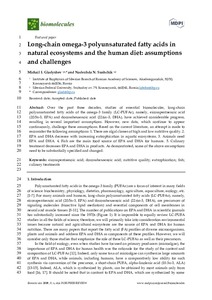Показать сокращенную информацию
Long-chain omega-3 polyunsaturated fatty acids in natural ecosystems and the human diet: assumptions and challenges
| Автор | Gladyshev, M. I. | |
| Автор | Sushchik, N. N. | |
| Дата внесения | 2020-01-20T07:56:34Z | |
| Дата, когда ресурс стал доступен | 2020-01-20T07:56:34Z | |
| Дата публикации | 2019-09 | |
| Библиографическое описание | Gladyshev, M. I. Long-chain omega-3 polyunsaturated fatty acids in natural ecosystems and the human diet: assumptions and challenges [Текст] / M. I. Gladyshev, N. N. Sushchik // Biomolecules. — 2019. — Т. 9 (№ 9). — С. 485 | |
| ISSN | 2218273X | |
| URI (для ссылок/цитирований) | https://www.mdpi.com/2218-273X/9/9/485 | |
| URI (для ссылок/цитирований) | https://elib.sfu-kras.ru/handle/2311/129260 | |
| Аннотация | Over the past three decades, studies of essential biomolecules, long-chain polyunsaturated fatty acids of the omega-3 family (LC-PUFAs), namely eicosapentaenoic acid (20:5n-3, EPA) and docosahexaenoic acid (22:6n-3, DHA), have made considerable progress, resulting in several important assumptions. However, new data, which continue to appear, challenge these assumptions. Based on the current literature, an attempt is made to reconsider the following assumptions: 1. There are algal classes of high and low nutritive quality. 2. EPA and DHA decrease with increasing eutrophication in aquatic ecosystems. 3. Animals need EPA and DHA. 4. Fish are the main food source of EPA and DHA for humans. 5. Culinary treatment decreases EPA and DHA in products. As demonstrated, some of the above assumptions need to be substantially specified and changed. | |
| Тема | eicosapentaenoic acid | |
| Тема | docosahexaenoic acid | |
| Тема | nutritive quality | |
| Тема | eutrophication | |
| Тема | fish | |
| Тема | culinary treatments | |
| Название | Long-chain omega-3 polyunsaturated fatty acids in natural ecosystems and the human diet: assumptions and challenges | |
| Тип | Journal Article | |
| Тип | Journal Article Preprint | |
| Страницы | 485 | |
| ГРНТИ | 34.35.33 | |
| Дата обновления | 2020-01-20T07:56:34Z | |
| DOI | 10.3390/biom9090485 | |
| Институт | Институт фундаментальной биологии и биотехнологии | |
| Подразделение | Кафедра водных и наземных экосистем | |
| Журнал | Biomolecules | |
| Квартиль журнала в Scopus | Q1 | |
| Квартиль журнала в Web of Science | Q1 |

